Do you ever want super strong abs, like a washboard tummy? But working out often doesn’t always make your lower abs look better, right? Strange.
Here’s the deal: your core is like a team. Everyone, not just some players, needs to be strong. If you ignore your lower abs, your core can become unstable, which can hurt your back and posture.
But don’t worry!
We got this! We’ll fix it with our expert-recommended exercises for lower abs. These exercises will work on your lower abs and strengthen your core and give you six-pack abs.

- Lower Abs Muscles
- How Do You Work On Your Lower Abs?
- 10 Best Exercise To Work Lower Abs
- 1. Incline Reverse Crunch
- 2. Hanging Straight Leg Raise
- 3. Stability Ball Knee Tuck
- 5. Cross-Body Mountain Climber
- 5. Scissor Kicks
- 6. Spiderman Plank
- 7. Dumbbell V-Up
- 8. Flutter Kicks
- 9. Cable Twist
- 10. Landmine Twists
- Best Ways To Reduce Your Lower Abs Fat
- 1. Do Lower Abs Workout
- 2. Reduce Overall Body Fat Loss
- 3. High-Intensity Interval Training (HIIT) To Burn Fat
- 4. Strength Training
- 5. Follow Proper Nutrition
- 6. Caloric Deficit
- Conclusion
- 20 Lower Ab Exercises
Lower Abs Muscles
The two rectus abdominis muscles (one on each side) are encased in a sheath of fascia that is responsible for the “six-pack” appearance.
The lower abs muscle arises from the lower margin of the rib cage and sternum and passes vertically downward to attach to the pubic bone.
To keep things simple, the bottom portion of the rectus abdominis is called the lower abs.
If your goal is to improve the definition of the bottom of your abdominal, you’re actually targeting the same muscles.
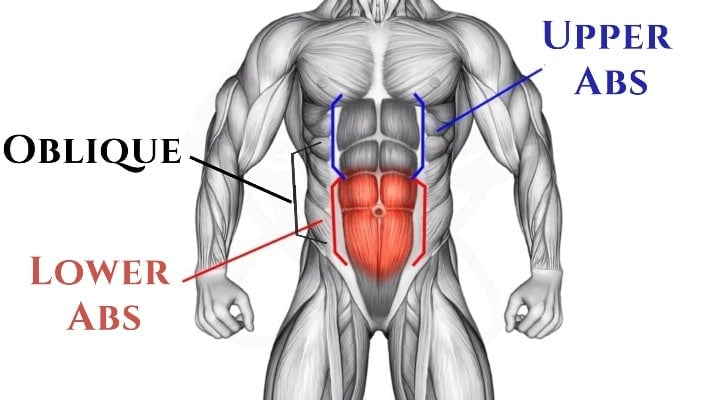
How Do You Work On Your Lower Abs?
It is important to remember when trying to target the lower abs muscles that there is no true isolation exercise for any of them, and this muscle group is designed to work together.
Even though some exercises hit the lower abs more than others, all of them will work together throughout the movement.
- The main job of the rectus abdominal is flexion of the torso, which means forward bending (bringing your chest toward your hips).
- And flexion of the hips means bringing your pelvic bone/hips upward.
So, to target your lower abs, think of movements that bring your thighs closer to your core.
Now that we understand, we need to focus on targeting the flexion of the hips to work the lower abs.
Here are some of the best exercises for activating the lower abs area.
- Bicycles
- Reverse crunches
- Planks with a knee drive
- Hanging leg raises
BODY FAT % CALCULATOR: KNOW YOUR BODY FAT PERCENTAGE TO GET VISIBLE ABS
10 Best Exercise To Work Lower Abs
Now that you understand the importance and anatomy of the lower abs, let’s dive into the top 10 best lower abs exercises you can add to your gym routine.
1. Incline Reverse Crunch
The incline reverse crunch is similar to the traditional reverse crunch except that it is performed on an incline bench.
Doing the exercise on an inclined bench adds resistance to the movement, making it more challenging and effective for developing abs.
In addition to engaging the lower abs, the incline reverse crunch engages the entire core, including the rectus abdominis, transversus abdominis, and obliques.
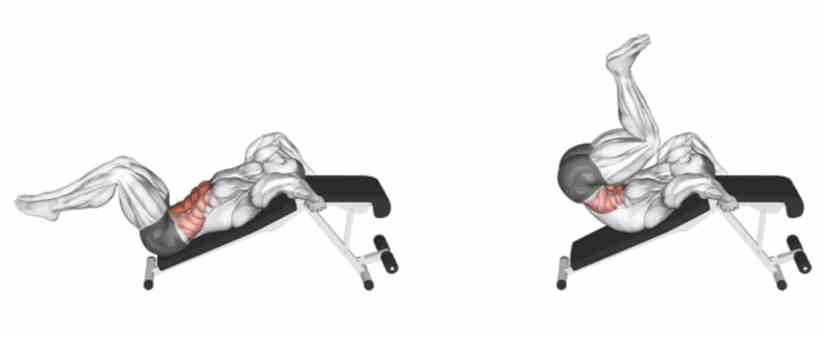
How To Do Incline Reverse Crunch
- Set an incline bench or incline board at a moderate incline angle (typically around 45 degrees).
- Lie on your back on the bench. Use the leg pads to hold your torso in place.
- Bend your hips and knees to 90-degree angles for the start position of the reverse crunch.
- Contract your abs and lift your legs towards your chest, curling your pelvis upward.
- Pause momentarily at the top of the movement, squeezing your abs.
- Slowly lower your legs back to the starting position in a controlled manner.
Tips
- Keep the movement slow and controlled.
- Visualize pulling your belly button towards your spine as you lift your legs.
- To add more resistance, increase the incline by raising the bench.
2. Hanging Straight Leg Raise
A hanging leg raise is an exercise that primarily works the lower abs and hip flexors and is a great addition to any fitness routine for overall core strength, spine health, and mobility.
In fact, studies have shown that hanging leg raises activated the rectus abdominis by 100% and activated the oblique muscles by 88%.
Hang on a pull-up bar and lift your legs, and your abs will tighten and strengthen.

How To Do Hanging Straight Leg Raise
- Grab a bar with an overhead grip, with the hands slightly wider than shoulder-width.
- Keep your core and glutes tight to keep your back and hips in the correct position.
- Keep your legs straight. Lift both legs toward your chest using your hips and ab muscles. Exhale as you lift your legs up.
- Slowly lower your legs back to the start position without swinging, inhaling as you go down.
Tips
- If you’re a beginner, do the bent knee variation and gradually straighten your legs as you get better at this exercise.
- Do this in a controlled motion while lifting your legs until they are at a 90-degree angle.
- Pull your legs up as high as you can above your waistline for a harder variation.
Know More: Best Abs Workout That You Can Do At Gym
3. Stability Ball Knee Tuck
The stability ball knee Tuck is a challenging core exercise that engages the lower abs, hip flexors, and stabilizing muscles. This exercise involves using a stability ball to perform a tuck motion, which mimics the movement of pulling your knees towards your chest while maintaining balance on the ball.
It is one of those abdominal exercises that looks like they are fun to do, but it is a very effective exercise.
It targets the major muscle groups of the core, while also targeting the stabilizing muscles of the chest, shoulders, and hips.
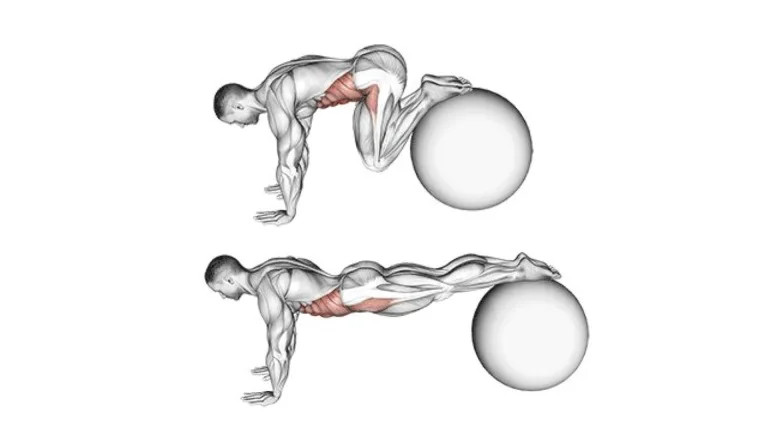
How To Do Stability Ball knee Tuck
- Place your hands on the floor shoulder-width apart, fingers facing forward.
- Place your shins or the tops of your feet on top of the stability ball.
- Engage your core muscles and lift your hips to create a straight line from your head to your heels.
- Use your lower abs to pull your knees towards your chest and roll the stability ball forward.
- At the top of the movement, stop and squeeze your abs.
- Slowly extend your legs and roll the stability ball back to the starting position.
Tips
- Avoid sagging or arching your back. Keep your neck neutral.
- Do not allow your hips to sag throughout the movement.
5. Cross-Body Mountain Climber
It is an explosive bodyweight exercise that engages multiple core muscles at once. It helps you improve your balance, agility, coordination, strength, and flexibility with just one exercise.
As you perform the move, your shoulders, arms, and chest work to stabilize your upper body while your core stabilizes the rest of your body.
As the prime mover, your quads and hamstring get an incredible workout, too.

How To Do Cross-Body Mountain Climber
- Start in the push-up position with your arms completely straight and directly beneath your shoulders.
- Your body should form a straight line from your shoulders to your ankles.
- Squeeze your abs, lift one foot off the floor and bring your left knee towards your right elbow while keeping your body in as straight of a line as possible.
- Return to the starting position and repeat the movement with your opposite leg.
Tips
- Don’t round your lower back.
- Don’t lift your hips too high. Your body should form a straight line from your shoulders to your ankles.
5. Scissor Kicks
Scissor kicks are a popular exercise that targets the lower abs, hip flexors, and inner thighs. During this exercise, you will alternate leg movements that resemble the motion of scissors.
If you’re new to scissor kicks, start with smaller leg movements, gradually increasing the range of motion as you build strength and control.
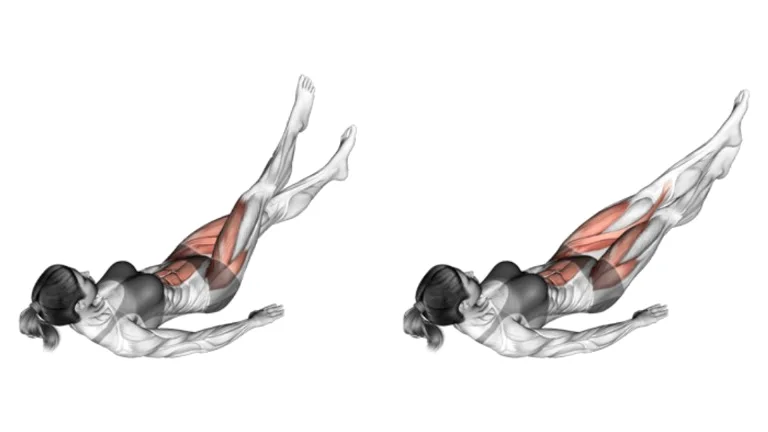
How To Do Scissor Kicks
- Lie flat on your back on a mat or the floor, keeping your arms by your sides with your palms facing down.
- Extend your legs fully and engage your core muscles by drawing your belly button in towards your spine.
- Lift your legs a few inches off the ground, keeping them straight and close together.
- Start the scissor motion by lifting one leg higher while simultaneously lowering the other leg towards the ground, crossing them over each other.
- Pause briefly when one leg is higher than the other, then reverse the motion, lifting the opposite leg while lowering the other leg.
- Continue the scissor-like movement, alternating your leg positions in a controlled and rhythmic manner.
- Aim to perform the exercise for a specific number of repetitions or a set duration.
Tips
- Keep your lower back pressed against the floor.
- Avoid swinging your legs or lifting them too high.
- Remember to breathe steadily and naturally
Read More: 18 Abs Exercises You Can Do At Home Without Equipment
6. Spiderman Plank
Spiderman plank workout is a very challenging and effective way. It will strengthen the core and flatten your stomach.
This exercise adds a dynamic element to the traditional plank by incorporating a knee-to-elbow movement
A dynamic movement to plank exercises is a great way to make the core work extra hard, especially the lower abs, obliques, and hip flexors.
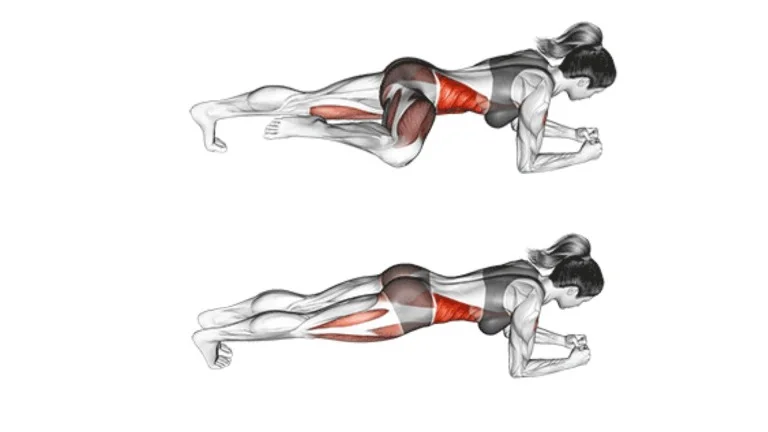
How To Do Spiderman Plank
- Start to get in a push-up position, bend your elbows and rest your weight on your forearms instead of on your hands.
- Engage your core muscles and keep your body in a straight line from head to heels.
- Bring your right foot forward and place it next to your right hand (or as close as you can).
- Pause for a moment, feeling the contraction in your abs and obliques.
- Slowly return your right leg to the starting position, extending it back.
- Repeat the movement on the other side, bringing your left knee towards your left elbow.
- Alternate between right and left for the desired number of repetitions or time.
Tips
- Keep your body in a straight line
- Keep your neck relaxed.
7. Dumbbell V-Up
The Dumbbell V-Up also known as a jackknife is a full-body move that works your core, legs, back, and shoulders.
The exercise is designed to work the obliques and abs, including the lower and upper abs muscles simultaneously.
A V-Up involves sitting on the floor or a mat and positioning the body in the shape of the letter V. It requires you to lift the weight of both your arms and legs by using your abdominal muscles.
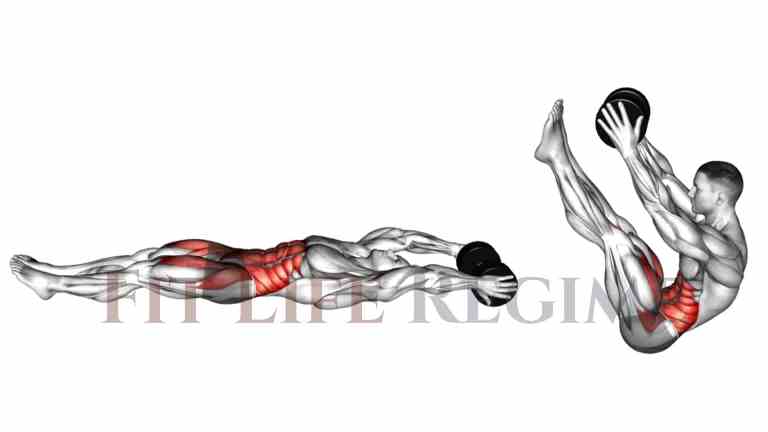
How To Do Dumbbell V-Up
- Lie down on the floor on your back, hold a dumbbell and extend the arms straight back behind your head.
- Your legs should also be extended.
- Exhale and bend at your waist while raising your legs and arms to meet in a jackknife movement.
- Try to hold the contracted position.
- Lower your arms and legs back to the starting position, inhaling as you do so.
Tips
- Keep the movement slow and controlled.
- Try to keep your back as straight as you can during the V sit up.
8. Flutter Kicks
Flutter kicks are an exercise that works the muscles of your core, specifically the lower abdominal muscles and the hip flexors.
The exercises help you shed some extra fat from the belly, hips, and thigh area and tighten your abs for better strength.
While doing this dumbbell abs workout, make sure to keep your core super tight and lower back flat on the ground.
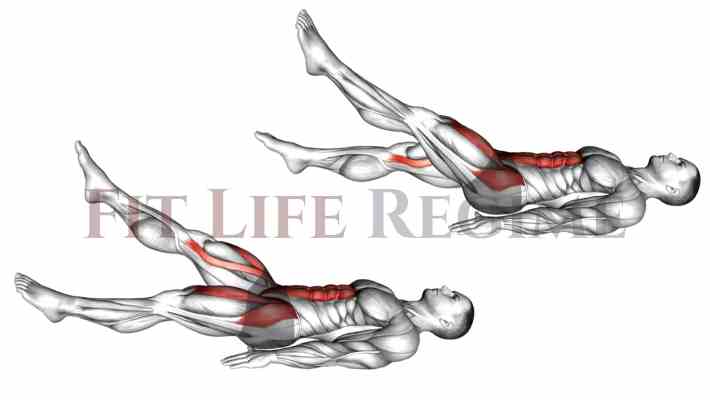
How To Do Weighted Flutter Kicks
- Lie on your back and hold a dumbbell in both hands.
- Hold the weight straight above your shoulders.
- Lift your shoulders and upper torso off the ground.
- Raise your legs a few inches off the ground and flutter kick your feet.
- If your back comes off the ground, or you feel any strain, bring your legs up a couple more inches.
Tips
- Keep the movement slow and controlled.
- Tighten your abs for better strength.
9. Cable Twist
The Cable twist, unique in that it not only helps to strengthen the core muscles, but it’s a functional exercise because it is performed on the feet.
It strengthens and defines the sides of your waist by working on the oblique muscles. It also engages the entire core, including the rectus abdominis and transversus abdominis.
The exercise improves rotational strength and stability, which is good for many sports and activities that require twisting or turning movements.

How To Do Cable Twist
- Attach a handle to a shoulder-height cable pulley.
- Grasp the handle with both hands, either with your fingers interlaced or with one hand over the other.
- Stand next to the machine with your feet shoulder-width apart.
- Keeping your arms straight, pull the handle in a twisting motion across your body to your opposite side until your torso faces away from the pulley.
- Hold for a count of two. Then slowly reverse the movement to return to the starting position.
- Repeat for the prescribed number of repetitions. Repeat the exercise on your opposite side.
Tips
- Keep your arms straight, shoulders locked in place.
- Avoiding slouching or leaning forward.
- Don’t lock the knees and hips. Allow the hips and knees to rotate slightly.
- Control the weight the whole time.
Know More: Most Effective Abs & Oblique Cable Exercises & Workout
10. Landmine Twists
The landmine twist is a rotational abdominal movement performed using an angled barbell anchored at floor level in a landmine device.
The exercise targets the entire core, including the rectus abdominis, the transversus abdominis, and the deep stabilizing muscle.
The exercise promotes proper posture and alignment by targeting the muscles that support the spine and improve spinal mobility.
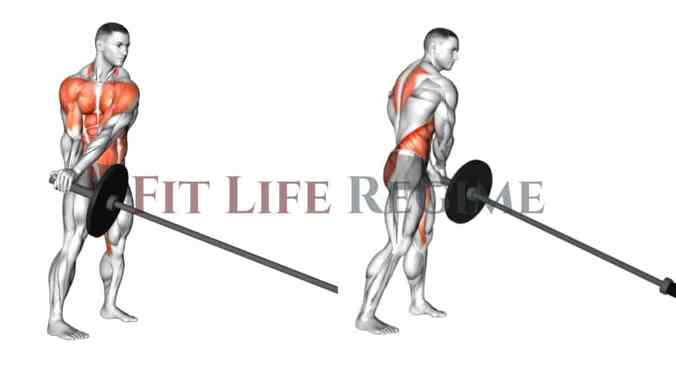
How To Do Landmine Twists
- Position a bar into a landmine or securely anchor it in a corner. Load the bar to an appropriate weight.
- Raise the bar off the floor, taking it to shoulder height with both hands with your arms extended in front of you. Adopt a wide stance.
- Rotate the trunk and hips as you swing the weight all the way down to one side. Keep your arms extended throughout the exercise.
- Reverse the motion to swing the weight all the way to the opposite side.
Tips
- Keep a slight bend in your knees as you rotate, this should help take a bit of tension off your lumbar spine during the movement.
- Try to keep your arms straight.
Know More: Best Abs Exercises: Upper Abs, Lower Abs, Obliques
Best Ways To Reduce Your Lower Abs Fat
To achieve a defined and sculpted midsection, you must focus on exercise, diet and overall fat loss.
The following is a point-by-point guide to achieving lower abs:
1. Do Lower Abs Workout
Make sure to include exercises that target the lower abs in your abs workout routine.
Here’s a sample lower abs workout plan that you can try:
- Hanging Leg Raises – 3 sets of 10-15 reps
- Scissor Kicks – 3 sets of 10-15 reps
- Reverse Crunches – 3 sets of 10-15 reps
- Dumbbell V-Ups – 2 sets of 10-15 reps
Remember to balance your lower abs exercises with other core exercises that target the upper abs, obliques, and back.
2. Reduce Overall Body Fat Loss
Even though targeted exercises can help build and tone muscles, they won’t be visible if they’re covered by body fat.
To show off your lower abs, you need to lose body fat through diet and cardio exercises.
3. High-Intensity Interval Training (HIIT) To Burn Fat
To maximize calorie burn and promote fat loss, incorporate high intensity interval training into your routine.
This exercise has been shown to increase metabolism and promote fat-burning even after the workout. Consider incorporating HIIT sessions into your weekly routine to maximize calorie burn.
These workouts involve short bursts of intense exercise followed by brief recovery periods. Examples include sprinting, jumping jacks, burpees, or cycling.
4. Strength Training
Strength training exercises should be included in your routine to build lean muscle mass. As muscle builds up, your body will burn more calories when you are at rest.
Use exercises that work multiple muscle groups, like squats, lunges, deadlifts, and chest presses.
These intense workouts demand more energy and can increase your metabolic rate both during the workout and afterward as your body recovers.
5. Follow Proper Nutrition
Follow a balanced diet that is rich in whole, unprocessed foods. Focus on lean proteins, complex carbohydrates, healthy fats, and plenty of fruits and vegetables.
Maintain a balanced macronutrient intake to support fat loss while preserving muscle mass.
- Lean protein sources (such as chicken, fish, tofu, and legumes) to support muscle recovery and growth.
- Consume complex carbohydrates (such as whole grains, sweet potatoes, and quinoa) for sustained energy levels.
- Eat healthy fats (such as avocados, nuts, and olive oil) for overall health.
6. Caloric Deficit
To lose body fat and show off your lower abs, you need to make a caloric deficit. This means eating fewer calories than your body needs, which forces your body to use stored fat for energy.
Calculate your daily caloric needs and aim for a moderate caloric deficit, typically around 500 calories per day.
Want To Build Six Pack ABS: Use Our Free Calculator To Know Your Fat Loss Calories Requirement
Conclusion
A targeted lower ab workout can help you achieve a sculpted and defined midsection. To achieve visible lower abs, you need to combine targeted workouts with a balanced diet and overall fat loss.
Results won’t happen overnight, but you can make progress towards your lower abs goals with dedication and commitment.
So get to the gym, stay focused, and enjoy the journey towards your lower abs goals.
20 Lower Ab Exercises

Manish brings over 10 years of hands-on experience in weight lifting and fat loss to fitness coaching. He specializes in gym-based training and has a lot of knowledge about exercise, lifting technique, biomechanics, and more.
Through “Fit Life Regime,” he generously shares the insights he’s gained over a decade in the field. His goal is to equip others with the knowledge to start their own fitness journey.
